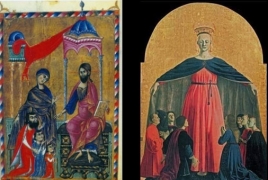 Armenian RenaissanceAhead of Europe The Renaissance in Armenia started long before it arrived in Europe. Humanistic ideas characteristic for Renaissance were not re-opened in Armenia but ‘crystallized’ in line with the Christian norms. In Armenian reality, this period was the continuation of pre-Christian ideas, which evolved into new practice, giving birth to new art and outlook. PanARMENIAN.Net - “The Armenian Renaissance can be divided into two periods,” art critic Anush Hakobian says. “These are the medieval time lasting from the 10th to 14th century and the classical period of the 18th century. We can say that the first period starts with the poetry of Grigor Narekatsi (Gregory of Narek), who dares to begin a dialogue with God.” The European Renaissance, in turn, marks the transition from the medieval ideology that infringes on human dignity towards antique vision basing on ancient views, where the human being is the central figure of the creation. This is the period when a man’s heavenly nature is revived. He is no more a kneeling and crooked slave but a part of God’s intention. “Renaissance is an evident breakthrough of thought and practice as compared to the Middle Ages. It is a cultural trend that influenced the intellectual life of the early period of modernity. Emerging in Italy in the 16th century and spreading across Europe, this epoch left its mark in literature, art, philosophy, politics, science, religion and other. The outstanding figures of Renaissance were guided by humanism, while artists strived towards realism and depiction of human emotions,” Hakobian says. On the left: Holy Mother pleads for duke Vasak and his sons. Vasak’s book of gospels, 13th century. On the left: Madonna of Mercy, Piero della Francesca “I would like to emphasize that Renaissance was also remarkable for the development of scientific thought, which gave impetus to the development of civilization. For example, Grigor Tatevatsi (14th century) dissertated about colors, giving a scientific explanation to the structure of color and introduces the notion of 5th element – the or – which symbolizes God’s presence. It should be noted that such kind of ideas emerged in Europe in the 16th century. The peculiarity of the first period of Armenian Renaissance is freedom, which, unlike medieval Europe, was not reduced to church doctrine. The clergy did not hamper the development of ideas as a continuation of evolved thought. Meanwhile, medieval concept of politicized Christian thought spared no effort to keep the flock in mystical fear and obedience. Basilicas, which symbolized faith, presented a lot of visual effects with a purpose to attract the flock and at the same time suppress the human mind: statues, frescos, stained glass windows, etc. The concept of Armenian church architecture implied austerity and spirituality along with developing architectural styles: cross-buildings, domed basilicas, Zvartnots-like temples,” Hakobian says. Miniatures had a special place in Armenian Renaissance, specifically during the Cilician era, when new art rules were developed, namely the elements of secularism and ‘humanization’ of sainthood, a process that started in Europe only two centuries later. PanARMENIAN.Net / Tsets The Oscar-winning helmer who hopes to return to Armenia many, many times ICAE2018 proves a success Telling a story in a single image Chance to have another dream The other side of music How Indians turned into Armenian Gypsies Sights for Armenians in Iran |